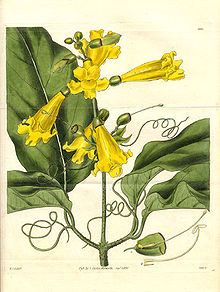Bignonia
Appearance
| Bignonia | |
|---|---|

| |
| Bignonia grandifolia | |
| Scientific classification | |
| Kingdom: | Plantae |
| Clade: | Tracheophytes |
| Clade: | Angiosperms |
| Clade: | Eudicots |
| Clade: | Asterids |
| Order: | Lamiales |
| Family: | Bignoniaceae |
| Tribe: | Bignonieae |
| Genus: | Bignonia L. nom. cons.[1] |
| Species | |
|
See text | |
| Synonyms[2] | |
| |
Bignonia is a genus of flowering plants in the catalpa family, Bignoniaceae. Its genus and family were named after Jean-Paul Bignon by his protégé Joseph Pitton de Tournefort in 1694, and the genus was established as part of modern botanical nomenclature in 1753 by Carl Linnaeus.
Species
Species include:[3]
- Bignonia binata Thunb.
- Bignonia bracteomana (K.Schum. ex Sprague) L.G.Lohmann
- Bignonia callistegioides Cham.
- Bignonia campanulata Cham.
- Bignonia capreolata L.
- Bignonia convolvuloides (Bureau & K.Schum.) L.G.Lohmann
- Bignonia corymbosa (Vent.) L.G.Lohmann
- Bignonia costata (Bureau & K.Schum.) L.G.Lohmann
- Bignonia cuneata (Dugand) L.G.Lohmann
- Bignonia decora (S.Moore) L.G.Lohmann
- Bignonia diversifolia Kunth
- Bignonia hyacinthina (Standl.) L.G.Lohmann
- Bignonia lilacina (A.H.Gentry) L.G.Lohmann
- Bignonia longiflora Cav.
- Bignonia magnifica W.Bull
- Bignonia microcalyx G.Mey.
- Bignonia neouliginosa L.G.Lohmann
- Bignonia nocturna (Barb.Rodr.) L.G.Lohmann
- Bignonia phellosperma (Hemsl.) L.G.Lohmann
- Bignonia potosina (K.Schum. & Loes.) L.G.Lohmann
- Bignonia prieurei DC.
- Bignonia pterocalyx (Sprague ex Urb.) L.G.Lohmann
- Bignonia ramantacea (Mart. ex DC.) L.G.Lohmann
- Bignonia sciuripabula (K.Schum.) L.G.Lohmann
- Bignonia sordida (Bureau & K.Schum.) L.G.Lohmann
- Bignonia uleana (Kraenzl.) L.G.Lohmann
References
- ^ The International Plant Names Index
- ^ "World Checklist of Selected Plant Families". Retrieved November 16, 2016.
- ^ The Plant List: A Working List of All Plant Species, retrieved November 16, 2016
External links
Wikimedia Commons has media related to Bignonia.
Wikispecies has information related to Bignonia.
